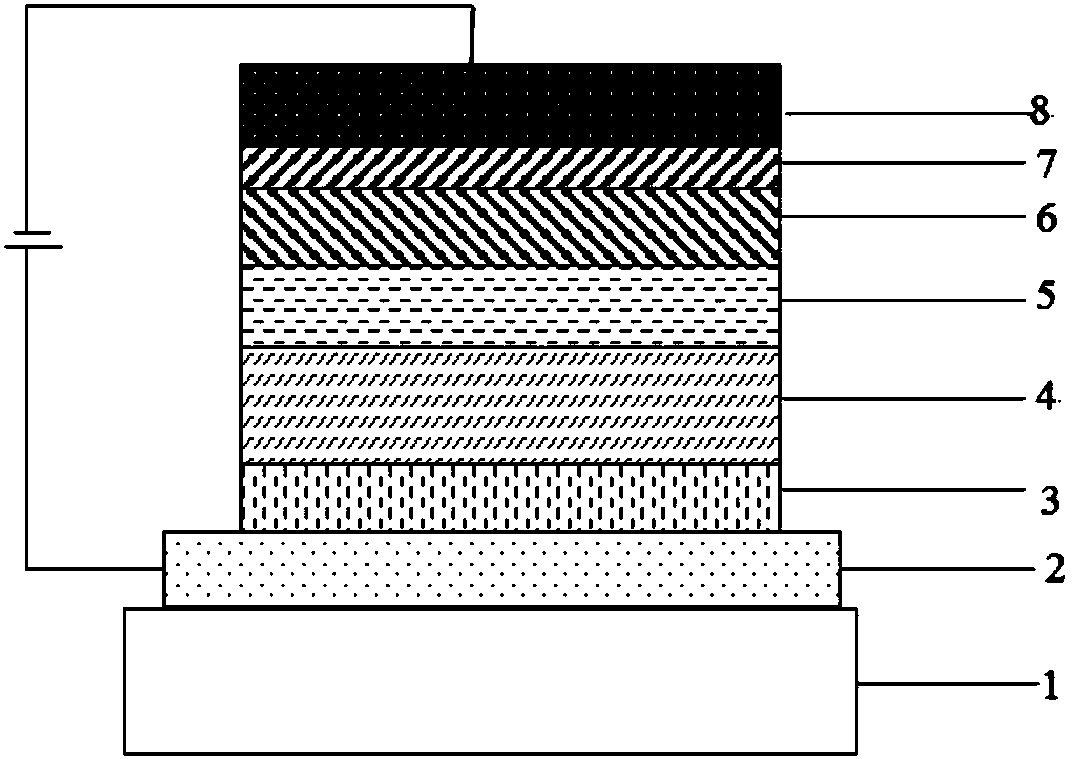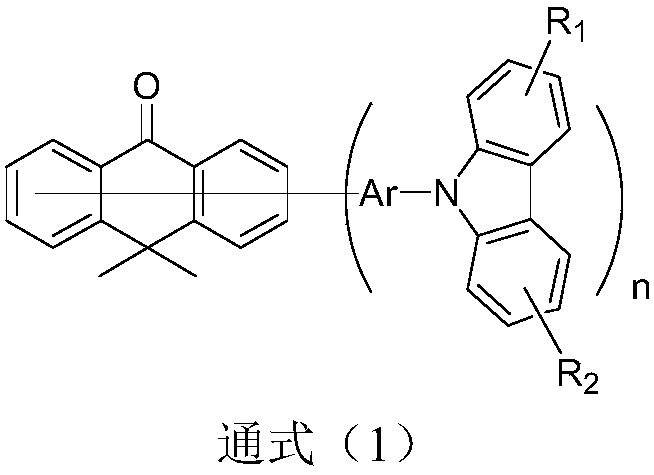Compound taking dimethyl anthrone as core and application of compound to organic electroluminescence device
A technology of dimethyl anthrone and compound, which is applied to the application field of organic electroluminescent devices, can solve problems such as different performances, and achieve the effects of improving physical and chemical properties, improving luminous efficiency, and avoiding aggregation.
- Summary
- Abstract
- Description
- Claims
- Application Information
AI Technical Summary
Problems solved by technology
Method used
Image
Examples
Embodiment 1
[0039] Embodiment 1: the synthesis of compound 1
[0040]
[0041] In a 500mL three-neck flask, under the protection of nitrogen, add 0.03mol 3,6-dibromocarbazole, 0.07mol raw material B1, 250mL toluene and stir to mix, then add 0.09mol sodium tert-butoxide, 0.0015mol Pd 2 (dba) 3 , 0.002mol tri-tert-butylphosphine, heated to 120°C, and refluxed for 24 hours; naturally cooled to room temperature, filtered, and the filtrate was subjected to vacuum rotary evaporation (-0.09MPa, 85°C), and passed through a neutral silica gel column to obtain the intermediate P1;
[0042] In a 250ml three-neck flask, under the protection of nitrogen, add 0.03mol intermediate P1, 0.036mol 1,4-dibromobenzene, 150ml toluene, stir and mix, then add 0.09mol sodium tert-butoxide, 0.002mol Pd 2 (dba) 3 , 0.002mol tri-tert-butylphosphine, stirring and heating to 115°C, reflux reaction for 24 hours, sampling point plate, showing that no intermediate P1 remains, and the reaction is complete; naturally...
Embodiment 2
[0046] Embodiment 2: the synthesis of compound 4
[0047]
[0048] In a 500mL three-neck flask, under nitrogen protection, add 0.03mol 3,6-dibromocarbazole, 0.07mol raw material B2, 250mL toluene and stir to mix, then add 0.09mol sodium tert-butoxide, 0.0015mol Pd 2 (dba) 3 , 0.002mol tri-tert-butylphosphine, heated to 120°C, and refluxed for 24 hours; naturally cooled to room temperature, filtered, and the filtrate was subjected to vacuum rotary evaporation (-0.09MPa, 85°C), and passed through a neutral silica gel column to obtain the intermediate P2;
[0049] In a 250ml three-neck flask, under the protection of nitrogen, add 0.03mol intermediate P2, 0.036mol 1,4-dibromobenzene, 150ml toluene, stir and mix, then add 0.09mol sodium tert-butoxide, 0.002mol Pd 2 (dba) 3 , 0.002mol tri-tert-butylphosphine, stirring and heating to 115°C, reflux reaction for 24 hours, sampling point plate, showing that there is no intermediate P2 remaining, the reaction is complete; naturally...
Embodiment 3
[0053] Embodiment 3: the synthesis of compound 23
[0054]
[0055] In a 500mL three-neck flask, under nitrogen protection, add 0.03mol 3,6-dibromocarbazole, 0.07mol raw material B3, 250mL toluene and stir to mix, then add 0.09mol sodium tert-butoxide, 0.0015mol Pd 2 (dba) 3 , 0.002mol tri-tert-butylphosphine, heated to 120°C, and refluxed for 24 hours; naturally cooled to room temperature, filtered, and the filtrate was subjected to vacuum rotary evaporation (-0.09MPa, 85°C), and passed through a neutral silica gel column to obtain the intermediate P3;
[0056] In a 250ml three-neck flask, under the protection of nitrogen, add 0.03mol intermediate P3, 0.036mol 1,4-dibromobenzene, 150ml toluene, stir and mix, then add 0.09mol sodium tert-butoxide, 0.002mol Pd 2 (dba) 3 , 0.002mol tri-tert-butylphosphine, stirring and heating to 115°C, reflux reaction for 24 hours, sampling point plate, showing that there is no intermediate P3 remaining, the reaction is complete; naturall...
PUM
| Property | Measurement | Unit |
|---|---|---|
| thickness | aaaaa | aaaaa |
| thickness | aaaaa | aaaaa |
| thickness | aaaaa | aaaaa |
Abstract
Description
Claims
Application Information
 Login to View More
Login to View More - R&D
- Intellectual Property
- Life Sciences
- Materials
- Tech Scout
- Unparalleled Data Quality
- Higher Quality Content
- 60% Fewer Hallucinations
Browse by: Latest US Patents, China's latest patents, Technical Efficacy Thesaurus, Application Domain, Technology Topic, Popular Technical Reports.
© 2025 PatSnap. All rights reserved.Legal|Privacy policy|Modern Slavery Act Transparency Statement|Sitemap|About US| Contact US: help@patsnap.com



